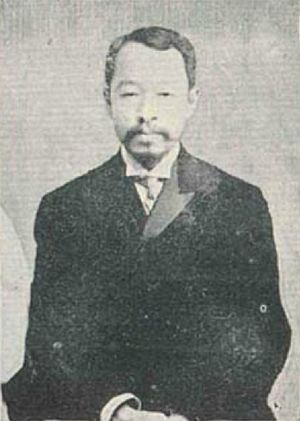Park Yung-hyo facts for kids
Quick facts for kids
Park Yung-hyo
|
|
|---|---|
 |
|
| Prime Minister of Joseon | |
| In office May 21, 1895 – May 31, 1895 |
|
| Monarch | Gojong |
| Preceded by | Kim Hong-jip |
| Succeeded by | Bak Jeongyang |
| Personal details | |
| Born | 1861 Suwon, Kingdom of Joseon |
| Died | 21 September 1939 (aged 78) Keijo, Japanese Korea |
| Relatives | Bannam Park clan |
| Park Yung-hyo | |
| Hangul |
박영효
|
|---|---|
| Hanja | |
| Revised Romanization | Pak Yeonghyo |
| McCune–Reischauer | Pak Yŏnghyo |
| Art name | |
| Hangul |
춘고 or 현현거사
|
| Hanja | |
| Revised Romanization | Chungo or Hyeonhyeon-geosa |
| McCune–Reischauer | Ch'un'ko or Hyǒnhyǒn-kǒsa |
| Courtesy name | |
| Hangul |
자순
|
| Hanja | |
| Revised Romanization | Jasun |
| McCune–Reischauer | Ch'asun |
| Japanese name: Yamasaki Eiharu (山崎永春) |
|
Park Yung-hyo (Korean: 박영효; Hanja: 朴泳孝; 1861 – 21 September 1939) was an important Korean politician during the Joseon Dynasty. He was known for his efforts to bring new ideas and changes to Korea. He also worked as a diplomat.
Park Yung-hyo became a member of the royal family when he married Princess Yeonghye. She was the daughter of King Cheoljong. He was also one of the people who planned the Gapsin Coup in 1884. This was an attempt to change the government.
Contents
Early Life and Education
Park Yung-hyo was born in Suwon, which is south of Hanseong. He was the third son in his family. His mother was Lady Yi.
In 1872, he was chosen to marry Princess Yeonghye. She was the only living daughter of King Cheoljong. King Cheoljong was the 25th ruler of the Joseon Dynasty. Sadly, the princess passed away just three months after their wedding.
Park Yung-hyo strongly supported the "Enlightenment Party." This group wanted to make big changes in Korea. They aimed to improve the government, economy, and military. They believed that using Western technology and methods would make Korea stronger. This was important to help Korea stand up to other countries. He traveled to Tokyo with Kim Ok-gyun. There, they met important Japanese politicians like Fukuzawa Yukichi.
Career
Creating the Korean Flag
Park Yung-hyo is famous for helping to create the first Korean national flag. This happened in 1882.
The Gapsin Coup
In 1884, Park Yung-hyo was one of the main leaders of the Gapsin Coup. This was a plan to change the government. The goal was to bring in new, Western-style reforms. However, the coup only lasted for three days. Chinese troops quickly stopped it. After the coup failed, Park Yung-hyo had to leave Korea. He went to Japan, where he first stayed with Fukuzawa Yukichi. Later, he moved to Kobe.
Later Political Roles
Park Yung-hyo returned to Korea in 1894. This was after the Japanese Occupation of Gyeongbokgung Palace. He wanted to help reform the country. However, people were still worried about the failed Gapsin Coup. So, he did not gain much political power at first. He even had to flee to Incheon.
After Japan won the Battle of Pyongyang (1894), public opinion in Korea began to change. People started to see Japan as a strong power in Asia. In December 1894, Park Yung-hyo and others who had returned from Japan gained more political influence. He became the Minister of Interior in the Second Kim Hong-jip cabinet.
Park Yung-hyo did not want to be controlled by Japan. He tried to build his own political support. He appointed Lee Kyu-wan as the police commander. He also made Ryu Hyeok-ro the Director of Artillery. However, after some major reforms and the assassination of Queen Min, Park fled to Japan again. He stayed there until 1907.
When he returned to Korea in 1907, he took on the role of Royal Household Minister. This was under Yi Wan-yong.
After the Japan-Korea Treaty of 1910, Korea became part of the Empire of Japan. Park Yung-hyo was given a special title in Japan. He became a marquess (koshaku). He also got a seat in the House of Peers in the Japanese parliament. He held many important positions during this time. He was the Director of the Bank of Chosen in 1918. He was also Chairman of the Korean Economic Association in 1919. In 1920, he became the first president of The Dong-a Ilbo newspaper. He also served as president of the Kyungbang Corporation. In 1921, he was chairman of the Korea Industrialization Bank. He also worked as an advisor to the Government-General of Korea’s Central Institute.
Family
Park Yung-hyo had a granddaughter named Park Chan-ju (1914 – 1995). She married Yi U (1912 - 1945). They had a son named Yi Cheong (born 1936).
Writings
- Sahwa giryak (사화기략, 使和記略)
See also
- Ye Wanyong
- Bak Jesun
- Yun Chi-ho

